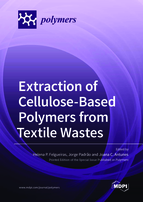Extraction of Cellulose-Based Polymers from Textile Wastes
A special issue of Polymers (ISSN 2073-4360). This special issue belongs to the section "Circular and Green Polymer Science".
Deadline for manuscript submissions: closed (31 January 2022) | Viewed by 39274
Special Issue Editors
Interests: antimicrobial agents; regenerative cues; drug delivery; biomaterials; wound healing; medical textiles; polymer processing; nano- and microfiber scaffolding systems
Special Issues, Collections and Topics in MDPI journals
Interests: textile materials; biotechnology; biomaterials; antimicrobials; bioreactor optimization; nanotechnology; environmental biotechnology; industrial biotechnology
Special Issues, Collections and Topics in MDPI journals
Interests: bioengineering; nanotechnology; biomaterials; polymer processing; controlled drug delivery; targeted delivery; tissue regeneration; antimicrobial strategies; bioactive molecules
Special Issues, Collections and Topics in MDPI journals
Special Issue Information
Dear Colleagues,
With the booming of nanotechnology in response to the demands for new and improved bio-based products, the extraction and exploration of cellulose-based polymers is becoming an exciting area of research. To date, wood (especially from bleached kraft wood pulp) has been the main source of cellulosic compounds because of its abundance in nature. However, in the past decade, researchers have been devoted to finding alternatives to extract cellulose from byproducts of agricultural crops and/or textile wastes, which are highly available at a very reduced raw material cost. The consumption of cotton-based products has been growing steadily over the past few decades. As a result of this increased consumption, the amount of cotton waste generated, including both pre-consumer (fiber linters, yarn slivers, fabric scraps from factory offcuts, unsold brand-new garments) and post-consumer (used and unwanted garments) wastes, has increased substantially in landfills. In finished cotton fabrics, cellulose content can be up to 99% since non-cellulose components are eliminated during scouring and bleaching, which are routine preparation procedures. Considering the urgent demands for a circular economy and sustainable actions, research has been providing the first steps towards finding new and greener extraction systems for textile wastes that provide the present raw materials with a second life. This Special Issue seeks manuscript submissions that further our understanding of these techniques and extractions processes employed to textile waste, and the mechanisms by which a second-life purpose can be provided to the extracted raw material. Studies that deal with the ability to recover cellulose-based polymers, with elevated purity, from cotton wastes are highly desirable. Submissions on new processing and extraction methodologies that employ green approaches, with a smaller environment impact than conventional strategies and that are capable of giving rise to high purity polymers are also very welcome.
Dr. Helena P. Felgueiras
Dr. Jorge Padrão
Dr. Joana C. Antunes
Guest Editors
Keywords
- textile fabrics
- recycling
- chemical extraction
- green methodologies
- natural-origin polymers
- polymer purity
- sustainability
- circular economy
- second-life polymer applications









